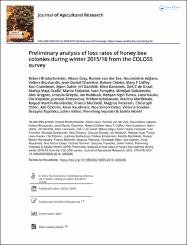| dc.contributor.author | Brodschneider, Robert | |
| dc.contributor.author | Gray, Alison | |
| dc.contributor.author | van der Zee, Romee | |
| dc.contributor.author | Adjlane, Noureddine | |
| dc.contributor.author | Brusbardis, Valters | |
| dc.contributor.author | Charriere, Jean-Daniel | |
| dc.contributor.author | Vejsnaes, Flemming | |
| dc.contributor.author | İvgin Tunca, Rahşan | |
| dc.date.accessioned | 2020-11-20T15:03:06Z | |
| dc.date.available | 2020-11-20T15:03:06Z | |
| dc.date.issued | 2016 | |
| dc.identifier.issn | 0021-8839 | |
| dc.identifier.issn | 2078-6913 | |
| dc.identifier.uri | https://doi.org/10.1080/00218839.2016.1260240 | |
| dc.identifier.uri | https://hdl.handle.net/20.500.12809/2661 | |
| dc.description | WOS: 000390325700003 | en_US |
| dc.description.abstract | In this short note we present comparable loss rates of honey bee colonies during winter 2015/16 from 29 countries, obtained with the COLOSS questionnaire. Altogether, we received valid answers from 19,952 beekeepers. These beekeepers collectively wintered 421,238 colonies, and reported 18,587 colonies with unsolvable queen problems and 32,048 dead colonies after winter. This gives an overall loss rate of 12.0% (95% confidence interval 11.8-12.2%) during winter 2015/16, with marked differences among countries. Beekeepers in the present study assessed 7.6% (95% CI 7.4-7.8%) of their colonies as dead or empty, and 4.4% (95% CI 4.3-4.5%) as having unsolvable queen problems after winter. The overall analysis showed that small operations suffered higher losses than larger ones. A table with detailed results and a map showing response and relative risks at regional level are presented. | en_US |
| dc.description.sponsorship | COST ActionEuropean Cooperation in Science and Technology (COST) [FA0803]; Ricola Foundation - Nature Culture; Austrian Federal Ministry of Agriculture, Forestry, Environment and Water Management [100972] | en_US |
| dc.description.sponsorship | The colony loss monitoring group which carried out this study is a core project of the COLOSS Association. COLOSS supports regular workshops facilitating research discussions and collaboration between group members, and aims to explain and prevent massive honey bee colony losses. It was funded through the COST Action FA0803 and is now supported by the Ricola Foundation - Nature & Culture. The authors thank very much the many beekeepers who completed the COLOSS questionnaire providing the data for this work. The authors are also grateful to various national funding sources for their support of some of the monitoring surveys. Open Access was provided by the project "Zukunft Biene" (grant number: 100972) funded by the Austrian Federal Ministry of Agriculture, Forestry, Environment and Water Management. | en_US |
| dc.item-language.iso | eng | en_US |
| dc.publisher | Taylor & Francis Ltd | en_US |
| dc.item-rights | info:eu-repo/semantics/openAccess | en_US |
| dc.subject | Apis Mellifera | en_US |
| dc.subject | Apiculture | en_US |
| dc.subject | Colony Loss | en_US |
| dc.subject | Monitoring | en_US |
| dc.subject | Winter Survival | en_US |
| dc.subject | Beekeeping | en_US |
| dc.subject | Survey | en_US |
| dc.subject | Citizen Science | en_US |
| dc.title | Preliminary analysis of loss rates of honey bee colonies during winter 2015/16 from the COLOSS survey | en_US |
| dc.item-type | article | en_US |
| dc.contributor.department | MÜ, Ula Ali Koçman Meslek Yüksekokulu, Bitkisel Ve Hayvansal Üretim Bölümü | en_US |
| dc.contributor.institutionauthor | İvgin Tunca, Rahşan | |
| dc.identifier.doi | 10.1080/00218839.2016.1260240 | |
| dc.identifier.volume | 55 | en_US |
| dc.identifier.issue | 5 | en_US |
| dc.identifier.startpage | 375 | en_US |
| dc.identifier.endpage | 378 | en_US |
| dc.relation.journal | Journal of Apicultural Research | en_US |
| dc.relation.publicationcategory | Makale - Uluslararası Hakemli Dergi - Kurum Öğretim Elemanı | en_US |


















